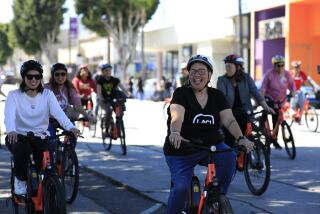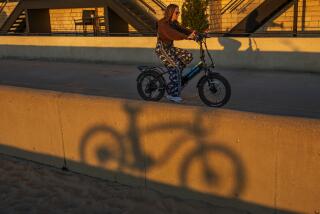Culture : Havana, in a Crunch, Pedals Toward Future : The bicycle is Cuba’s answer to fuel rationing. The cash-strapped government pushes riding as a way to relax, slim down and get places quicker, and Cubans are biting.
- Share via
HAVANA — Manuel Gonzalez, an electric company engineer, suffered the daily 17-mile trek from his home in suburban Guanabacoa to downtown Havana on a wheezing, clattering, Hungarian-made bus.
First he had to wait too long at the bus stop, then bulldoze his 220-pound frame down an aisle jammed with sweltering strap-hangers. The ordeal lasted up to two hours each way--four hours every workday. Until last April.
Then, at age 30, Gonzalez acquired his first bicycle and learned to ride. After a few wobbly days, it began to change him as remarkably as it is changing Havana’s cityscape.
Gonzalez, now down to 181 pounds and pedaling to work in less than an hour, is one of 300,000 habaneros issued bicycles under a year-old crash program to conserve Cuba’s dwindling fuel supplies. In a city with fewer than one-fourth that many private cars, two-wheeled commuters now dominate the broad boulevards and rocky beaches.
“It’s good for my health, my energy level, my speed, my strength, my state of mind,” the electrician said as he and his wife, Anibaliza, stopped their sturdy Chinese-made bikes along Havana Bay during the morning rush. “Going places doesn’t make me angry anymore.”
“And look,” his wife added, hugging his waist, “A lot of this has disappeared.”
During half a day of cycling about this city of 2 million people, a Times correspondent heard many such testimonials. While shoppers in food lines complain bitterly about the worst shortages of President Fidel Castro’s revolution, bikers seem happy with their new toys.
“On my bici ,” exclaimed 20-year-old Zorro Solis, who pedals to work as a hotel chambermaid, “it’s like summer year-round.”
Bicis , in fact, are the only welcome product of a crisis that has put nearly every consumer item under severe rationing since the middle of last year.
Castro ordered the austerity, known as the “special period in time of peace,” to cope with the loss of Cuba’s Cold War trading allies in Eastern Europe and shortages of imports from a disintegrating Soviet Union. With buses starved for imported fuel and spare parts, the number of daily riders in Havana has been cut from 32,000 to 20,000. Gasoline for private cars is rationed at 16 gallons a month.
As an alternative, the government a year ago began importing Chinese bicycle parts for assembly here and ordered five factories to gear up for production. About 500,000 of Cuba’s 10 million people now have bikes. By next summer, 1 million are supposed to be in circulation; by 1995, 3 million.
The new bikes, with names like Phoenix, Flying Pigeon and Follow Me, weigh 37 to 40 pounds and have hand brakes but no gears. For workers they cost the equivalent of $120, half the average monthly salary--with a year to pay. For students they cost $60.
In a country that is also replacing tractors with oxcarts, the proliferation of bicycles might look like a sign that Cuba, after three decades of communism, is marching back to the 19th Century.
“Definitely not!” declares government economist Eugenio R. Balari. “If saving fuel, reducing air and noise pollution, improving the health of the population and humanizing the city is going backward, then what does it mean to advance?”
Balari, who is president of Cuba’s Institute for the Research and Orientation of Internal Demand and who cycles five miles a day, has been promoting the bike as a mass transit alternative for years. It wasn’t until the “special period” that his idea caught on within the government.
“A favorable set of circumstances has convinced everyone, and now the bicycle is here to stay,” he said in an interview. “It’s a king’s gift . . . a very noble vehicle. . . . Just look at the streets. There’s bicycle fury out there.”
The government-controlled media has chimed in, hailing the bicycle as a way to relax, slim down and get places quicker. Trabajadores, a magazine for workers, advises young brides that cycling can reduce the pain of childbirth.
As a result, the “culture of the bicycle” that Balari envisions is taking shape in Havana.
All main thoroughfares have bike lanes with signs reading: “Atencion! Ciclos en la Via” (Careful! Cycles on the Road). Bike racks are taking over the parking lots of factories, offices and beaches. Special buses, with their seats removed, shuttle 2,000 bikers and their machines each day through the narrow, half-mile tunnel under Havana Bay.
The most striking thing about a bicycle tour of Havana is the feeling of having the city to oneself.
Havana is an open-air museum, a crumbling but graceful metropolis with Spanish colonial architecture, a curving seawall and lumbering, American-made automobiles predating Castro’s 1959 takeover. The city is too spread out for a walking tour, but seeing it by car or bus dilutes the charm. The bike is a liberating compromise: You can see it all, up close, stopping where you want.
Automobile traffic is so scarce that, if you stay in the bike lanes and obey the traffic signals, you hardly notice it. And Havana’s flat terrain makes pedaling easy. The closest thing a Times reporter had to an accident was stopping to gaze at the Plaza de la Revolucion and nearly being rear-ended by another cyclist.
For road companions, the reporter had commuters riding to the office, vacationers cycling to the beach, fishermen pedaling down to the seawall, young men carrying their girlfriends on the tandem fender, women with children on the handlebars, shoppers laden with plastic sacks and a fumigator with pesticide containers mounted on back. Even some police officers were patrolling on bikes.
If the country is tense over its economic crisis, you wouldn’t suspect it in the bike lane.
“It’s a long ride but something I look forward to every day,” said Maria Elena Valdes, 34, who lives 12 miles from her office job. “With the sea at my side and the wind in my hair, I feel freer.”
Castro, 65, does not pedal in public. But his speeches promote the bicycle as one more symbol of his resolve to keep steering an orthodox socialist course, despite the changes in the Soviet Union. “The revolution is like a bicycle,” he once declared. “It has brakes but no reverse.”
Like other products of a centrally planned economy, bicycles are turned out according to production quotas, not consumer demand, and distributed not by the market but by Communist Party officials in each school and workplace. (People commuting two to seven miles each way get priority.)
But policy-makers are debating whether bike repair shops, now state owned, should be privatized to ensure better service. Meanwhile, demand for bikes has outrun the supply, creating a black market where official prices are often tripled.
“When there’s such a scarcity of everything and you introduce a product like the bicycle, everyone wants one whether he needs it or not,” said Manuel Moreno Frajinals, a cultural historian. “If they put tricycles on sale, soon everyone would be riding one.”
Indeed, there’s more to the cycling boom than necessity. Packs of teen-agers cruise the Malecon, Havana’s seaside boulevard, riding with no hands or with front wheels aloft. They take turns swerving from the bike lane in front of motorists--a game to see who can force the most cars to screech their tires.
The Communist Party newspaper Granma reported 26 deaths and 118 injuries in 171 bike-related accidents from January through May this year. Police have started fining bikers the equivalent of $5 for life-threatening infractions, such as clinging to the rear of moving buses, and $2 for ignoring traffic signals or riding in the wrong direction.
The Times reporter’s peaceful ride on the Malecon was disrupted when a gang of young cyclists sped past, three abreast in the bike lane and two over the line. A motorcyclist swerved to avoid them, shouting a protest.
The bike gang responded with a torrent of unprintable abuse against the motorcyclist’s mother.
“The bikers think they own the road,” said Sergio Talavera, a Havana police officer who witnessed the incident but did not give chase. “We’re constantly repeating the rules of safety, on radio and television. They know the rules. They just do those crazy things on purpose.”
More to Read
Sign up for Essential California
The most important California stories and recommendations in your inbox every morning.
You may occasionally receive promotional content from the Los Angeles Times.













